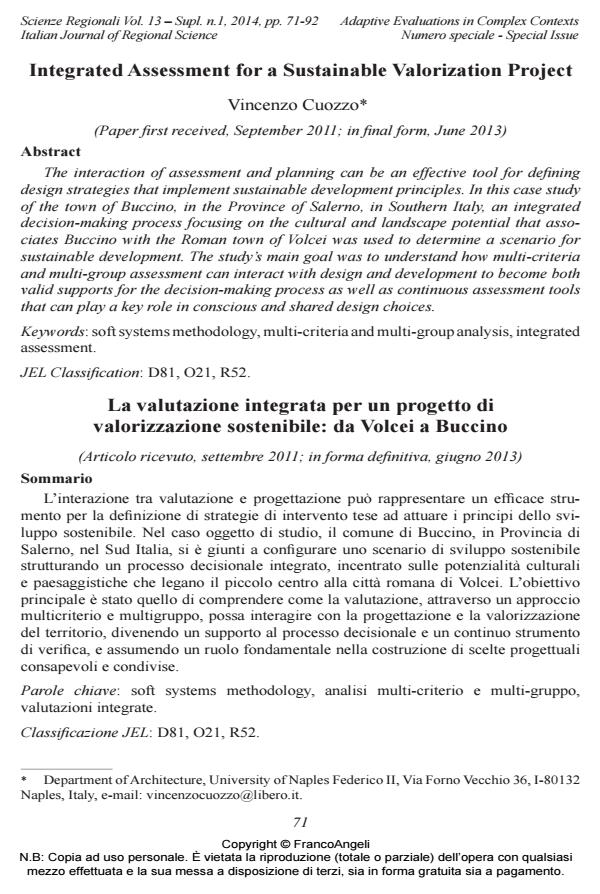Integrated Assessment for a Sustainable Valorization Project
Journal title SCIENZE REGIONALI
Author/s Francesca Ziller
Publishing Year 2014 Issue 2014/1 Suppl.
Language Italian Pages 22 P. 71-92 File size 1095 KB
DOI 10.3280/SCRE2014-S01004
DOI is like a bar code for intellectual property: to have more infomation
click here
Below, you can see the article first page
If you want to buy this article in PDF format, you can do it, following the instructions to buy download credits

FrancoAngeli is member of Publishers International Linking Association, Inc (PILA), a not-for-profit association which run the CrossRef service enabling links to and from online scholarly content.
The interaction of assessment and planning can be an effective tool for defining design strategies that implement sustainable development principles. In this case study of the town of Buccino, in the Province of Salerno, in Southern Italy, an integrated decision-making process focusing on the cultural and landscape potential that associates Buccino with the Roman town of Volcei was used to determine a scenario for sustainable development. The study’s main goal was to understand how multi-criteria and multi-group assessment can interact with design and development to become both valid supports for the decision-making process as well as continuous assessment tools that can play a key role in conscious and shared design choices. J
L’interazione tra valutazione e progettazione può rappresentare un efficace strumento per la definizione di strategie di intervento tese ad attuare i principi dello sviluppo sostenibile. Nel caso oggetto di studio, il comune di Buccino, in Provincia di Salerno, nel Sud Italia, si è giunti a configurare uno scenario di sviluppo sostenibile strutturando un processo decisionale integrato, incentrato sulle potenzialità culturali e paesaggistiche che legano il piccolo centro alla città romana di Volcei. L’obiettivo principale è stato quello di comprendere come la valutazione, attraverso un approccio multicriterio e multigruppo, possa interagire con la progettazione e la valorizzazione del territorio, divenendo un supporto al processo decisionale e un continuo strumento di verifica, e assumendo un ruolo fondamentale nella costruzione di scelte progettuali consapevoli e condivise.
Keywords: Soft systems methodology, multi-criteria and multi-group analysis, integrated assessment.
Jel codes: D81, O21, R52.
Francesca Ziller, Integrated Assessment for a Sustainable Valorization Project in "SCIENZE REGIONALI " 1 Suppl./2014, pp 71-92, DOI: 10.3280/SCRE2014-S01004